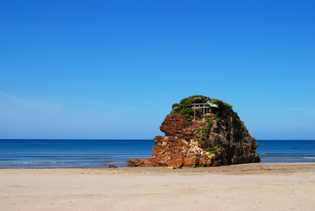大国主と国譲り - Okuninushi and the Land Offering
Okuninushi sent all the brother gods away, and had many children with many goddesses. He also started to build his country. The God Sukuna Hikona (who later went away), and many other gods, cooperated in building the new country. After overcoming many difficulties, they succeeded. At that time, when the rice began to ripen well in the vast fields, Amaterasu in Takamagahara thought that it was her descendants that should govern the country. She sent messengers to Okuninushi and requested that he give her his country. All the messengers she sent became allies of Okuninushi and didn’t return.
兄弟たちを追い払った後、大国主は幾人もの女神たちとの間にたくさんの子供を設けます。同時に、少名彦(すくなひこ・後にいなくなります)を始めとする多くの神々の力を借り自らの国を造ることにも着手し、幾多の困難を乗り越え成功を収めます。そして、広大な畑に稲がたわわに実るころ、天照は高天原で自分の子孫こそ大国主の国を支配するにふさわしいと考えていました。そこで天照は使いの者を大国主の元へ遣わせ、国を譲ってほしいと頼むのですが、送り出す使いの者はすべて大国主の味方についてしまい戻ってきません。
She finally sent the God of Sword and Thunder, Takemikazuchi, and the God of the Flying Ship, Ame no Torifune, to Okuninushi. The conference with Okuninushi and those Gods was held at the Inasa Beach in the town of Taisha, in front of the Byoibu Iwa, a huge stone standing by the Sea of Japan. Takemikazuchi swiftly drew his sword and stuck it into the ground, with its point up, and sat on its tip. He asked Okuninushi to offer his country to Amaterasu. Okuninushi said that he was too old to think and answer, so he wanted to have his son, Yae Kotoshironushi no Mikoto (also called Ebisu, one of The Seven Lucky Gods), answer for him.
遂には、剣と稲妻の神・建御雷(たけみがづち)と空飛ぶ船の神・天鳥船(あめのとりふね)を大国主の元へ送り込みます。二人の神と大国主は、現在の大社町にある稲佐の浜の波打ち際にそびえる巨大な岩・屏風岩の前で話し合います。そのとき、建御雷はすばやく剣を抜き取り、それを先端を上に向けて砂浜に突き刺しその上に腰を下ろしました。建御雷は大国主に向かって彼の国を天照に譲ってはくれぬかと申し出ますが、大国主は自分は答えを出すには年を取りすぎている、代わりに息子の八重事代主命(やえことしろぬしのみこと)に相手をさせようと言います(八重事代主命は七福神の中の一人恵比寿の別名です)。
However, Yae Kotoshironushi had gone fishing and bird hunting at Mihonoseki at that time. Ame no Torifune was sent to get Yae Kotoshironushi, and he brought him back to the Inasa Beach. (There is a festival at Miho no Seki, every year, commemorating that event.) Yae Kotoshironushi said that the word of Amaterasu was venerable, and that he would give up the country. Immediately after this comment, he hid himself behind a green hedge in the sea. Takemikazuchi asked Okuninushi for someone else to speak for him. Okuninushi replied that there was his son, Takeminakata. At the moment, Takeminakata came back to Izumo.
しかし、そのとき彼はあいにく魚と鳥を捕りに美保関に行っており不在でした。そこで、天鳥船が美保関まで出向き八重事代主を因幡海岸まで連れ戻しました(美保関ではこの出来事を記念して毎年お祭りが催されます)八重事代主は天照の言葉をありがたがり、国を譲ることを承諾します。そして、その意向を伝えるやいなや、海の中の緑の生垣の後ろに隠れてしまいました。 建御雷が大国主に代わりの者をよこすよう求めたところ、彼はもう一人の息子、建御名方(たけみなかた)の名を挙げます。丁度そのとき、建御名方が出雲へ戻ってきました。
He asked who the gods were, and picked a quarrel with Takemikazuchi. He grabbed the hand of Takemikazuchi, and tried to crush it. The hand turned into a sharp sword and Takeminakata was thrown to the ground. Then Takeminakata ran away to Suwa (Nagano Prefecture)! According to that story, Izumo no Kuni must have been closely related to Nagano at that time. This would be reason to assume that Izumo no Kuni was much larger than anyone has thought.
彼は二人の神とはだれであるか尋ね、それがわかると建御雷と口論を始めました。遂には建御雷の手をつかんでそれを押しつぶそうとします。すると、建御雷の手は鋭い剣へ変わり、建御名方を地面に投げ飛ばしてしまいました。建御名方は諏訪(今の長野県)へと逃げ込んでしまいます。この話から想像するに、当時出雲の国と諏訪の間には深いつながりがあったに違いありません。そしてこのことは、出雲の国が人々の想像をはるかに超える大きな国であったという推測の論拠となっています。
Okuninushi then swore to Amaterasu that he would offer the country to her under the condition that she should build a huge palace for him. The palace should have a pillar that would reach to the bottom of the ground, and a roof which would reach far above Takamagahara. If the palace would be built, Okuninushi would hide himself in it forever, and his children would never be traitors, like Yae Kotoshironushi. Thus, the huge palace, Izumo Taisha Shrine, was arranged to be built. There is a statue at the entrance to Izumo Taisha that commemorates that event. The golden ball represents Amaterasu.
大国主は、天照が彼のために大地に届く柱と高天原まで届くほど大きな宮殿を建てることを条件に自らの国を彼女に譲ることを申し出ます。そして宮殿が完成した暁には、八重事代主にされたように2度と子供たちに裏切られぬよう、永久にそこで隠遁生活を送るつもりでした。壮大な出雲大社はこうして完成したのです。入り口にはこの出来事にちなんだ像があります。金色の玉は天照を表しています。
The Japanese myths in the Kojiki are continued to the advent of the sons of Amaterasu, and the stories of the gods of three generations in Hyuga (Miyazaki Pref.). In the Izumo no Kuni Fudoki, the topographical book of Izumo, there are many myths written, which are different from those in the Kojiki.
古事記には天照の息子たち、さらには日向の国(現在の宮崎県)の三つの世代にわたる神々にまつわる神話などが記されています。 出雲の国風土記にも多くの神話が見受けられますが、それらは古事記にあるものとは異なっています。
